 Map of the center |
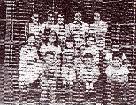 Children's Village for Orphans |
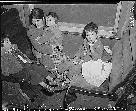 Mother and child evacuees of Japanese ancestry on this train en route to the relocation center at Manzanar, California from Los Angeles. |
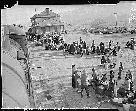 Evacuees of Japanese ancestry waiting to board buses which will take them to the War Relocation Authority center at Manzanar, California. |
 A street is being constructed at this War Relocation Authority center for evacuees of Japanese ancestry. |
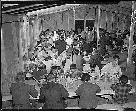 Mealtime at the Manzanar Relocation Center. Every effort is put forth to keep family groups intact in the dining halls as well as in their living quarters in the barracks. |
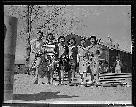 Enjoying an afternoon stroll at this War Relocation Authority Center for evacuees of Japanese ancestry. |
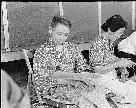 Typical Issei., 07/01/1942 |
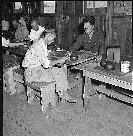 Playing the Japanese game Goh in the Relocation Hall at this War Relocation Authority center for evacuees of Japanese ancestry. |
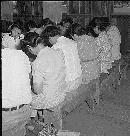 Part of a class under the Adult Education Program at this War Relocation Authority center. It is composed of Issei and Kibei evacuees who are studying the Ideals of American Citizenship and the English language with which they are unfamiliar. At this time there are 18 such classes averaging 20 each of voluntary enrollment. |
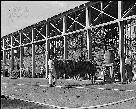 Making camouflage nets for the War Department. This is one of several War and Navy Department projects carried on by persons of Japanese ancestry in relocation centers. |
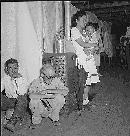 A typical interior scene in one of the barrack apartments at this center. Note the cloth partition which lends a small amount of privacy. |
 Hospital latrines, for patients, between the barracks, which serve temporarily as wards. For the first three months of occupancy medical facilities have been meager but the new hospital fully equipped, is almost ready for occupancy. |
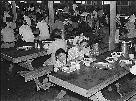 Mealtime in one of the messhalls at this War Relocation Authority center for evacuees of Japanese ancestry. |
 An evacuee orphan, one of 65 now housed in the Childrens' Village at this War Relocation Authority center for evacuees of Japanese ancestry. |
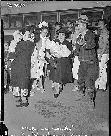 Before disembarking from bus at War Relocation Authority center, evacuees of Japanese descent are again examined by fellow evacuee medical staff. This baby (center) was found to have measles. The nurse is accompaning mother and child to Manzanar hospital. |
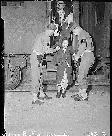 The Soldiers assist elderly evacuee of Japanese descent leave car steps in transfer to War Relocation Authority center at Manzanar. |
 Evacuees of Japanese ancestry arrive by bus from Lone Pine. They were taken there by train and thence to Manzanar, now a War Relocation Authority center. |
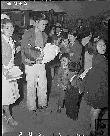 An evacuee family of Japanese descent is assisted by an evacuee nurse upon their arrival at this War Relocation Authority center. |
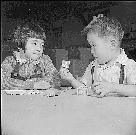 Playtime in the third grade class. |
 Pupils in the nursery school are taught that cleanliness is next to godliness. (Note toilet facilities on left.) |
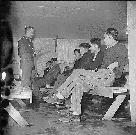 Lt. Eugene Bogard explaining the purpose of registration to Japanese and Japanese Americans. Similar meetings were held at all centers for the purpose of registering all evacuees between the ages of 18 and 38. |
 A meeting was held in one of the mess halls to explain to Japanese and Japanese Americans, the purpose of registration. Robert B. Cozzens, Assistant Field Director is here explaining the purposes of registration to a group of the evacuees. Left to right: Robert Cozzens, Assistant Field Director, (next unkown.), and Sergeant Victor Tierman. |
 Bulletins in English and in Japanese keep evacuees posted at this War Relocation Authority center. |
 Yaeko Yamashita (in doorway) watches Fugiko Koba trying a new pair of geta, which are stilt-like sandals especially useful in dust. They are evacuees of Japanese descent now living at this War Relocation Authority center. |
 Hanging curtains in their barrack apartment at this War Relocation Authority for evacuees of Japanese ancestry. |
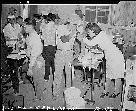 Newcomers vaccinated by fellow and sister evacuees of Japanese ancestry on arrival at Manzanar, a War Relocation Authority center. |
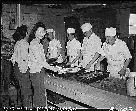 Mealtime, cafeteria style, at this War Relocation Authority center for evacuees of Japanese ancestry. |
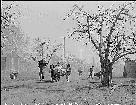 Newcomers move into Manzanar, a War Relocation Authoriy center for evacuees of Japanese ancestry. |
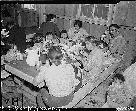 Mealtime during early days after evacuation at Manzanar, now a War Relocation Authority center for evacuees of Japanese ancestry. In housing, as well as at mealtime, family life is preserved. |
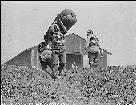 Evacuees of Japanese descent carry their personal effects preparatory to setting up housekeeping at this War Relocation Authortitycenter. |
 Army military police go on duty to guard the boundaries of this War Relocation Authority center for evacuees of Japanese ancestry. |
 Mealtime at Manzanar, a War Relocation Authority center for evacuees of Japanese ancestry. |
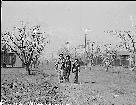 An afternoon stroll at this War Relocation Authority center for evacuees of Japanese ancestry |
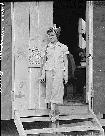 In the doorway of her barrack apartment at this War Relocation Authority center for evacuees of Japanese ancestry. |
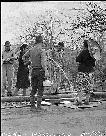 Residents of the Manzanar Center are shown waiting at the water hydrant for water for their barrack apartments. |
 Opportunities are offered for handicraft at this War Relocation Authority center for evacuees of Japanese ancestry. This craftsman is making geta - home-made wooden sandals. |
 Lucy Yonemitshu, former student from Los Angeles, California, enjoys a few free moments from her household duties and listens to swing music from her familiar and favorite Los Angeles radio station. |
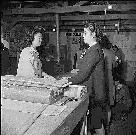 Material for a spring frock is selected by an evacuee housewife in the yardage department of the community store. |
 An elderly evacuee purchases peanut butter for a between meal snack. All meals for the residents are served in mess halls and are merely supplemented by tidbits which the evacuees prepared in their own barracks. |
 A view of the magazine and newpaper stand in the community store. George Yamashita is the manager of this newstand. |
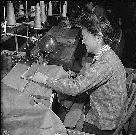 Mrs. Mary Nagao, former housewife from Los Angeles, California, now works as seamstress in the industrial division of the garment factory. Mrs. Nagao had had no previous experience in industrial garment making, prior to evacuation. She was trained, as were many others, as a seamstress in this plant. |
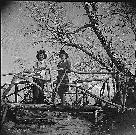 Toshiko Mikami and Kazuko Sakai, pretty Nisei girls, visit the picnic ground located on the banks of Shepards Creek, which runs through this relocation center. |
 Memorial |
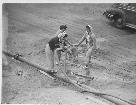 Relocated Nisei girls getting a bucket of water from one of the hydrants at this relocation center. 4/2/42 |
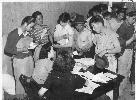 Vaccination is required of evacuees at War Relocation Authority centers to guard against typhoid and other diseases. 4/2/42 |
 Evacuees of Japanese ancestry are enjoying postal service at this War Relocation Authority center. This is a branch of the Los Angeles Post Office, more than 250 miles away, and a two-cent stamp will send a letter to and from Los Angeles. . 4/2/42 |
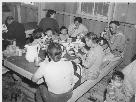 Mealtime during early days after evacuation at Manzanar, now a War Relocation Authority center for evacuees of Japanese ancestry. In housing, as well as at meal times, family life is observed. 4/2/42 |
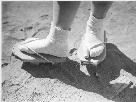 Close-up of geta, stilt-like sandals which are especially useful in dust. These are made by evacuee craftsmen in this War Relocation Authority center. 4/2/42 |
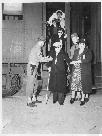 Evacuees of Japanese descent arrive here by train and await buses for Manzanar, now a War Relocation Authority center. |
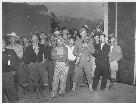 While military policeman stands guard, this detachment watches arrival of evacuees of Japanese ancestry at this War Relocation Authority center. 4/2/42 |
 Office and other workers are given opportunities to follow their callings at War Relocation Authority centers for evacuees of Japanese ancestry. Trudes Osajima, (above), switchboard operator in the Administration building. 4/2/42 |
 Children are taught democratic games in the nursery school at the Relocation Center. All desks, chairs, and other furnishings are made in the furniture factory, by evacuee workers. 2/10/43 |
 A pupil of the third grade is taught to read and enjoy children's books, like any other young American boy. This picture was taken in a student training center, where student teachers are given college credit for their work here. All classes are supervised by accredited teachers. |
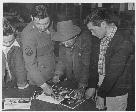 Life in an army camp is here explained by typical pictures to three evacuees by Sergeant Kenneth Uni, formerly from Honolulu. All evacuees between the ages of 18 and 38 were registered at the Manzanar Center, and all Japanese Americans were at this time given the opportunity to volunteer for service in the Army of the United States at Camp Shelby, Mississippi, where a unit composed entirely of persons of Japanese ancestry will take training for combat duty. 2/11/43 |
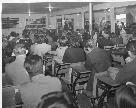 Lieutenant Eugene Bogard explaining registration purposes to a group of Japanese-Americans and Japanese who were evacuated from west coast defense areas. All persons between the ages of 18 and 38 were compelled to register. Seated is Sergeant Victor Tierman. 2/11/43 |
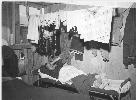 An evacuee resting on his cot after moving his belongings into this bare barracks room. Army cot and mattress are the only things furnished by the government. All personal belongings were brought by the evacuees. 4/2/42 |
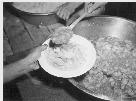 Meals are being served cafeteria style at this War Relocation Authority center. Photographer4/2/42 |
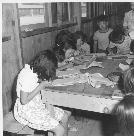 These young evacuees are attending the first elementary school at this War Relocation Authority center. There are six grades with volunteer teachers and voluntary attendance. 7/1/42 |
 Part of a line waiting for lunch outside the mess hall at noon. 7/1/42 |
 Evacuee family of Japanese ancestry relax in front of their barrack room at the end of day. The father is a worker on the farm project at this War Relocation Authority center. Note the chair which was made of scrap lumber, and the wooden shoes known as Getas made by the evacuees. |
 Shizuco Setoguchi is now assisting on the local newspaper, the Manzanar Free Press, at this War Relocation Authority center for evacuees of Japanese ancestry. Former occupation: Secretary. 7/3/42 |
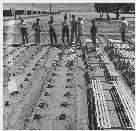 Guayule plantings are being inspected by Doctor Robert Emerson (third from right), a bio-chemist and botanist from the California Institute of Technology and director of the guayule rubber experiment. He is here shown conferring with several of his staff of young evacuee scientists at Plot 4. There are plants in this plot that have been in the ground for ten days. 6/28/42 |
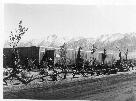 Exterior view of the lathe house for the guayule rubber experiments under the direction of Walter T. Watanabe, who has a staff of 25 workers at this War Relocation Authority Center. The initial shipment of 100,000 seedlings came from Salinas Experiment Station.. 6/29/42 |
 Evacuees enjoying the creek which flows along the outer border of this War Relocation Authority center. 7/3/42 |
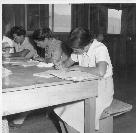 Part of a class under the Adult Education Program at this War Relocation Authority center. It is composed of Issei and Kibei evacuees who are studying the Ideals of American Citizenship and the English language with which they are unfamiliar. At this time there are 18 such classes averaging 20 volunteer members each and conducted by volunteer instructors. 7/3/42 |
 Oko Murata (left), and Esther Naito, office workers from Los Angeles, in their quarters at Manzanar, a War Relocation Authority center where evacuees of Japanese descent will spend the duration. These girls are Nisei (born in this country). They have set up a personal library in their quarters. They perform clerical duties in Manzanar. 5/30/42 |
 Orphan boys, two of a group of 65 who are now making their home in the Children's Village at this War Relocation Authority center for evacuees of Japanese ancestry. 7/1/42 |
It was the first of the relocation centers to be opened. It opened on March 21, 1942 after taking only six weeks to construct. The population eventually got to around 10,000.
All Japanese Americans orphans from the restricted zone were sent to Manzanar to the Children's Village structure. Over 100 children eventually were interned in that part of the camp.
From the Final Report: Japanese Evacuation from the West Coast 1942, published June 5, 1943, a description of the area: "Manzanar differs from the other Centers in that it was originally selected by the Western Defense Command as a Reception Center. The initial movement from the West Coast consisted of those Japanese who went from their homes directly to Manzanar beginning March 21, 1942. It was operated by the Wartime Civil Control Administration until May 31, 1942, when it was transferred to the War Relocation Authority.
"The Project site is situated in the Owens Valley, Inyo County, California, and consists of approximately 60,000 acres of land leased from teh City of Los Angeles. This land was acquired by the city when it built the Owens Valley Aqueduct, the most important part of the Los Angeles city water system. Formerly ranches and farms occupied this valley but during the thirty years of city ownership the land reverted to desert conditions. Under irrigation it is capable of producing heavy crops and the Japanese have been very successful in raising vegetables here."
Only 3 of around 800 original buildings remain.